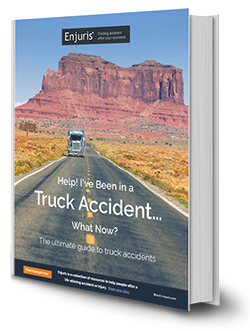A guide to commercial truck accidents and injury claims in the Old Dominion State
Virginia is home to 70,000 miles of public roads and 1,000 miles of interstate.
Every year, roughly 34,000 registered trucks use these roadways to transport more than 900 million tons of freight. All of this large truck traffic is good for Virginia's economy, but it's not so good for the safety of other road users.
A truck accident is more likely than a car accident to result in serious or fatal injuries. What's more, large truck accidents aren't always treated the same as car accidents under the law.
Let's take a look at some things you should know if you or a loved one is involved in a truck accident in the Old Dominion State.
Truck accident statistics
In Virginia, large truck crashes (semis, tractor-trailers, big rigs, etc.) made up only 1.9% of all traffic crashes in 2018. However, more than 35% of large truck accidents resulted in injury or death.
Across the United States, 4,136 people died in large truck crashes in 2018. Only 16% of these deaths were truck occupants, whereas 67% were occupants of passenger vehicles and 15% were pedestrians, bicyclists, or motorcyclists.
| Virginia crashes involving large trucks (2018) | |||
|---|---|---|---|
| Fatal | Injury | Property damage | Total |
| 49 | 842 | 1,649 | 2,540 |
Common causes of truck accidents
Truck accidents are devastating to passenger-vehicle occupants because trucks often weigh 20 to 30 times as much as passenger cars and are taller with greater ground clearance.
But what causes truck accidents?
The Federal Motor Carrier Safety Administration (FMCSA) investigated the actions that lead to large truck accidents and found that they could generally be broken down into 6 categories:
- Decision (38%): The driver was driving too fast for conditions, misjudged the speed of other vehicles, or followed other vehicles too closely.
- Recognition (28%): The driver was inattentive, was distracted by something inside or outside the vehicle, or failed to observe the situation adequately for some other reason.
- Non-performance (12%): The driver fell asleep, was disabled by a heart attack or seizure, or was physically impaired for another reason.
- Vehicle (10%): Vehicle failures, such as brake problems.
- Performance (9%): The driver panicked, overcompensated, or exercised poor directional control.
- Environment (3%): Fog, heavy rain, bad weather, or roadway problems.
The Virginia Department of Motor Vehicles (VDMV) tracked truck crashes in 2018 and found that the following truck driver actions preceded truck crashes:
| Virginia truck driver action preceding accident (2018) | ||
|---|---|---|
| Driver action | Number of accidents | Percentage of crashes |
| Improper lane change | 295 | 10.8% |
| Avoiding another vehicle | 58 | 2.1% |
| Avoiding pedestrian | 1 | 0.0% |
| Failure to yield | 44 | 1.6% |
| Following too closely | 247 | 9.0% |
| Hit and run | 22 | 0.8% |
| Improper parking | 17 | 0.6% |
| Improper backing | 34 | 1.2% |
| Improper passing | 18 | 0.7% |
| Improper turn | 81 | 3.0% |
| Left of center (not passing) | 19 | 0.7% |
| Ran traffic control | 16 | 0.6% |
| Speeding | 51 | 1.9% |
| Other | 567 | 20.8% |
| No improper action | 1,248 | 45.7% |
| Not provided | 14 | 0.5% |
Truck driver fatigue: a serious problem
Driver fatigue is a serious problem in the trucking industry. Fatigue can impact a driver's response times, ability to maintain focus, and ability to make good decisions.
According to a study conducted by the Federal Motor Carrier Safety Administration (FMCSA), approximately 13% of commercial vehicle drivers who crash are fatigued. Because of these risks, federal laws governing the trucking industry establish certain hours-of-service limitations that truck drivers must follow.
| Hours-of-service limitations for commercial drivers | ||
|---|---|---|
| Work | Property-carrying vehicles | Passenger-carrying vehicles |
| On-duty | Maximum 14 consecutive hours on-duty following 10 consecutive hours off-duty | Maximum 15 hours on-duty following 8 consecutive hours off-duty |
| Driving time | Maximum 11 hours of driving during the 14-hour on-duty period | Maximum 10 hours of driving following 8 consecutive hours off-duty |
| Weekly | Maximum 60 hours on-duty in any period of 7 consecutive days (if the vehicle operates every day) or maximum 70 hours on-duty in any period of 8 consecutive days (if the vehicle doesn't operate every day) | Maximum 60 hours on-duty in any period of 7 consecutive days (if the vehicle operates every day) or maximum 70 hours on-duty in any period of 8 consecutive days (if the vehicle doesn't operate every day) |
Source: Title 49 of the Federal Code of Regulations
Who's at fault in a truck accident?
To recover damages in a Virginia truck accident, you first need to prove that someone else was responsible (i.e., at fault) for the accident in which you were injured.
In most cases, the at-fault party will be one of the following:
- The truck driver. The truck driver may be at fault if they violated a rule of the road (such as running a red light or falling asleep behind the wheel).
- The trucking company. The trucking company may be at fault if they violated one of the applicable federal or state laws (such as requiring a truck driver to drive more hours than permitted under the law).
- The cargo company. Overloaded or improperly loaded cargo is a common cause of truck accidents and may result in the cargo company being held liable.
- The manufacturer. The manufacturer of a truck or truck component may be at fault if the accident was the result of a defect in the truck or truck component.
Respondeat superior
In Virginia, the legal theory of respondeat superior can be used to hold a trucking company responsible for the actions of its truck driver employees. Under this theory, the employer is liable for the actions of its employees so long as the driver's actions were:
- Unintentional, and
- Committed within the scope of the employee's employment and in furtherance of the employer's business.
Shared liability laws
Virginia is one of the few states in the country that follows the pure comparative fault rule. Under this rule, the plaintiff is prohibited from recovering ANY damages if they're found even the slightest bit at fault for the accident.
For example, if a jury finds that a truck driver was 97% at fault for your accident because the driver ran a red light, but also found that you were 3% at fault for failing to turn your headlights on at dusk, you'll be prohibited from recovering any damages.
This might not seem fair, but it's the law.
Truck accident damages
The bad news is that truck accidents often result in catastrophic damages. The good news is that Virginia allows truck accident victims to recover both economic and non-economic damages. Economic damages refer to the loss of monetary resources. Noneconomic damages are those damages that aren't easily quantifiable.
Here's a breakdown of what each category entails:
| Damages available in a Virginia truck accident lawsuit | |
|---|---|
| Economic damages | Non-economic damages |
| Property damages | Pain and suffering |
| Medical expenses | Emotional distress |
| Lost wages | Loss of consortium |
What happens if a loved one was killed in a truck accident?
In Virginia, certain family members can file a wrongful death lawsuit if their loved one was killed in a truck accident. Filing a wrongful death lawsuit is a lot like filing a negligence lawsuit in the sense that the family member still has to prove that the truck driver (or some party other than the deceased) was at fault in order to receive compensation.
Once the family member establishes liability, the family member can recover certain damages for the losses sustained as a result of the deceased's death (such as sorrow and mental anguish and the loss of the deceased's care).
What to do after a truck accident in Virginia
The steps you should take after a Virginia truck accident are similar to the steps you should take following a car accident in Virginia:
- Step 1: Seek medical treatment. Your health should be your first priority. If you're injured in a truck accident, call an ambulance or have someone at the scene call one for you.
- Step 2: Call the police. The police can help facilitate the exchange of information between you and the other drivers (particularly if road rage or an injury is involved). Additionally, police can conduct a brief investigation and draft a police report that might help support your claim.
- Step 3: Collect driver information. In Virginia, drivers are required to exchange their contact, registration, and license information.
- Step 4: Collect witness information. It's extremely difficult to locate witnesses days or even hours after an accident. Accordingly, while you may have a million other things on your mind, it's important to collect the contact information of any witnesses at the scene of the accident.
- Step 5: Collect any other evidence that might support your claim. Be sure to preserve any evidence that might help support your case. This may include pictures of property damage to your vehicle, road and weather conditions, and physical injuries you sustained.
- Step 6: Follow up with medical treatment. The insurance company or defendant in a truck accident case will look for reasons to limit the amount of damages you receive. One common tactic is to claim that you weren't seriously hurt because you didn't seek medical attention immediately following the accident or that you failed to follow the instructions of your doctor and therefore the insurance company or defendant shouldn't have to pay for your damages. Be sure to meet with a doctor as soon as possible after the accident and follow their advice.
- Step 7: Contact an attorney. The sooner you contact an attorney, the easier it is for the attorney to investigate your accident, gather evidence, and support your claim.
Did you know that truck accident law varies by state?
Need a lawyer?
Top causes of truck accidents and injuries
Truck accidents with passenger cars tend to result in more serious injuries than collisions between two or more passenger cars. Sometimes, the aftermath of a truck accident can stick with a person for life, which is why it's crucial that you receive the money you need to handle your ongoing and future medical and life care expenses. These serious injuries can include...















